2010 Honda Insight Hybrid First Drive

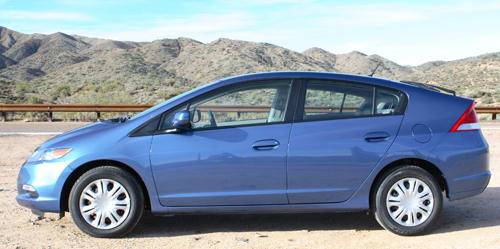
The Honda Insight name — used between 1999 and 2006 for the first gasoline-electric hybrid in North America — is back for 2009 as a 2010 model, this time representing an affordable four-door, five-seat hatchback. The original was a two-door two-seater. Honda won’t price the model until closer to April, when it hits dealerships, but the company promises it will be the most affordable hybrid on the market. That puts it below the 2009 Prius, which starts at $22,000.
Though Honda sold hybrid Accord sedans in the past and still markets a Civic Hybrid, the Insight is distinct because it’s a hybrid-only model, like the Toyota Prius. To cut to the chase, the Insight’s EPA-estimated mileage is 40/43 mpg, which in hybrid terms isn’t particularly impressive. The larger Civic Hybrid is rated 40/45 mpg, and the 2009 Prius rates 48/45 mpg. (What’s more, the 2010 Prius that will also debut in Detroit is rumored to be still more efficient.) However, I and many other drivers at the Insight’s national media preview last month in Arizona exceeded the EPA estimate handily.
People are already saying the 2009 Insight looks like the Prius. There’s no doubt that it does, but look at a photo of the Prius alongside the original Insight before drawing conclusions about who’s aping whom. Aerodynamics are critically important, and this is one of the most efficient shapes out there.
The Driving Experience
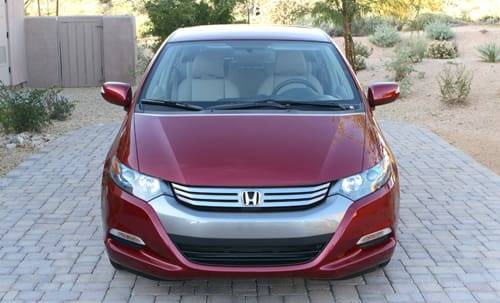
The Insight can accelerate on electric power alone up to 30 mph — 50 mph when going downhill — but it doesn’t have the silent, electric-only experience that most hybrids do. Honda says the big advancements in this new generation of hybrid are manufacturing cost and durability.
The Insight is pretty seamless as far as hybrids go. The brakes feel natural, as does the steering — pretty good for rear drum brakes and electric power steering. There’s some lag in accelerator response, but it has nothing to do with the car’s continuously variable automatic transmission. There is no manual Insight.
In the EX trim level, you get steering-wheel shift paddles so you can choose “gears” manually. A CVT has no fixed gears, so these seven settings are arbitrary ratios that the transmission hops among if you use the paddles. I think it’s a bit silly, but it’s viewed as sporty, and the Insight is intended to be more fun to drive than most hybrids. I think it is. There’s good steering feel and the handling is crisp. The added weight of the battery and other components is carried so low that it seems to lower the car’s center of gravity, which makes it feel grounded. Overall it’s way more engaging than the 2009 Prius, though in fairness that car’s technology is pretty outdated; Toyota hybrids introduced more recently are more refined, and the redesigned 2010 Prius is sure to be as well.
The ride quality is firm but good, and I think it’s less bumpy in the backseat than the Fit, perhaps thanks to the Insight’s longer wheelbase. The Insight’s cabin noise is admirably low considering affordable, efficient cars often omit noise-deadening measures in order to shave weight and improve mileage.
The Insight’s acceleration is merely good. The modest-power approach is one of the reasons the Prius has been such a hit, so it’s a bummer the Honda’s EPA figures aren’t better. The Insight is a hundred or so pounds lighter than the higher-rated Civic Hybrid, but its electric motor has 13 hp, versus the Civic Hybrid’s 20 hp. The gas engine is a 1.3-liter four-cylinder with 98 hp. For what it’s worth, I was racking up mpg in the mid- to high 40s during my few hours behind the wheel; a colleague got into the 50s, and a number of other drivers got into the 60s by hypermiling, the name used to describe a feather-footed driving style that maximizes efficiency. Ironically, being hyper doesn’t help at all; it should be called mellowmiling. The only one who’s hyper is the guy behind you who’s in five-alarm road rage while you accelerate on electric power trying to beat your high score.
There’s also an “econ” mode to help you in this endeavor. It makes the accelerator less sensitive and tries to keep the transmission in an efficient ratio. Econ is the default mode when you turn the car on. Even though the pedal is less responsive overall in this mode, if you floor it you get full power — a safe design.
Compared to some hybrids, especially the new Ford Fusion Hybrid, the Insight’s readouts are minimalist. It gives you basic power-flow information and both instantaneous and long-term mileage readouts on an LCD screen on the instrument panel. The digital speedometer’s background color changes from blue to blue-green to green to indicate when you’re driving most economically. It’s effective because the display sits high up, close to your line of sight, so your eyes aren’t fixed on a low-mounted display or gauge. You just catch the color at the edge of your vision. Unlike most hybrids, the Insight’s navigation system (available on the EX) doesn’t have supplemental hybrid graphics, nor does it have a backup camera.
The Insight shares its underlying structure, from the front bumper to the A-pillars, with the Honda Fit. The Insight is more than 10 inches longer than the Fit and about 5 inches shorter than the Civic Hybrid. Its A-pillars anchor pretty far forward, but there isn’t a large, peculiar-looking window extending in front of the doors like the Fit has.
There are few cues to distinguish the step-up EX trim level from the base LX. The latter has turn signals on its side mirrors, and it replaces the LX’s steel wheels with alloys. Both are 15 inches in diameter.
The Inside
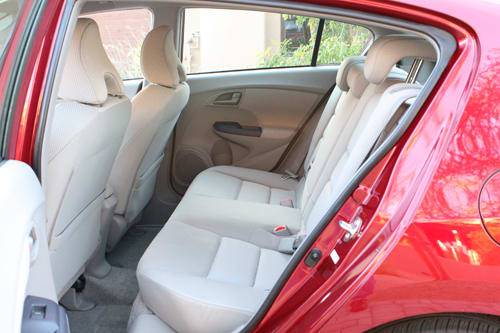
The Insight has 1 inch less headroom than the Civic and 2 inches less than the Fit, but I had enough room. Even with the height-adjustable driver’s seat jacked all the way up there were a couple inches to spare, and I’m about 6 feet tall. There was enough room for my legs, but they were stretched out pretty far forward. It’s better than not fitting in a car, but I felt like I was sitting on a speed bump, even with the seat at its highest point.
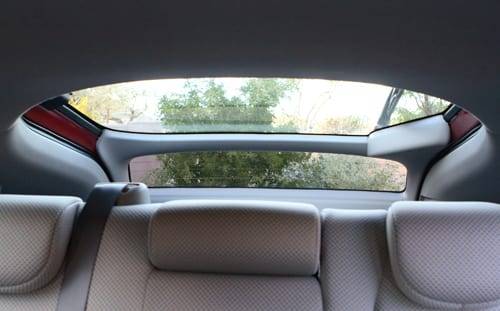
Visibility is very good to the front and sides, and the rear view is decent. Honda gets credit (or blame) for the bisected liftgate design that puts a separate rear window pane under a cross-member. It’s better known from the Prius hatchback, but it appeared first on the Honda CRX and then the first-gen Insight. I parked a 2009 Prius and the Insight the same distance from an orange cone and the visible height was almost identical. The fact that the Insight’s backseat head restraints collapse almost flush with the backrests helps open up the view more than in the Prius. (Note that a new-generation 2010 Prius wasn’t available yet for comparison.)
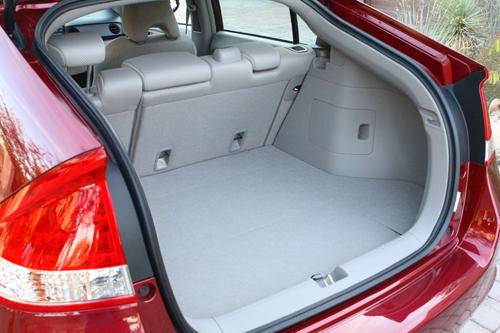
Interior Quality
Honda has been ahead of the curve in terms of the quality of its affordable-car interiors. The Insight is no different, with bright gauges and nice, low-gloss surfaces. The seat fabric is presentable, and it’s identical in the LX and EX trim levels. Leather isn’t offered. It’s mainly functional features that distinguish the EX, including cruise control, a USB audio interface, seatback pockets, visor vanity mirrors, a center armrest storage console between the front seats, and steering-wheel controls. I’m surprised that a hybrid would lack standard cruise control, as it helps maximize efficiency, but Honda is trying to keep the LX’s cost low. Nowadays, cruise control costs an automaker practically no hardware and little extra money, but in the Insight the feature requires the EX’s more complex steering wheel.
The Insight’s success will depend on how shoppers react to its EPA rating and/or whether they hear that the true results are better than the estimates — something automakers are prohibited from marketing. Before the 2008 change in its calculation methods, the EPA overestimated hybrid mileage — even more than it did non-hybrids — and now manufacturers seem to be paying the piper. For example, I’ve effortlessly achieved mileage well into the 50-mpg range in the current Prius. While it’s good that the Insight might exceed its ratings, it won’t be the only hybrid to do so.

Former Executive Editor Joe Wiesenfelder, a Cars.com launch veteran, led the car evaluation effort. He owns a 1984 Mercedes 300D and a 2002 Mazda Miata SE.
Featured stories




